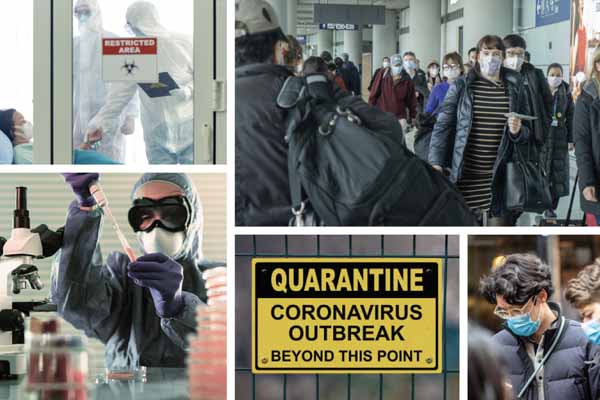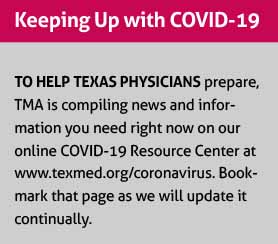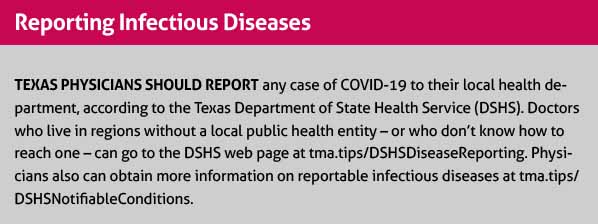
Texas’ first confirmed case of COVID-19 (short for coronavirus disease 2019), diagnosed Jan. 30, was a patient who traveled on a U.S. State Department chartered flight from China. The patient was immediately put under federal quarantine at the U.S. Air Force’s Joint Base San Antonio-Lackland without any contact with the public.
These kinds of containment measures may have helped delay the spread in the U.S. of the highly contagious infectious disease that the World Health Organization and U.S. Department of Health and Human Services have declared a public health emergency. But the virus – like previous coronaviruses such as SARS and MERS – is now part of the medical landscape, says John Hellerstedt, MD, commissioner of the Texas Department of State Health Services (DSHS).
“It’s always going to be around,” he said.
Texas is no stranger to novel or exotic diseases and the havoc they can cause, says Wendy Chung, MD, chief epidemiologist for Dallas County Health and Human Services and chair of the Texas Medical Association’s Council on Science and Public Health. In fact, the state has been through a series of high-profile outbreaks that continually remind physicians of the role doctors play in fighting them.
“Every physician is a public health provider,” she said. “I think that kind of message is increasingly understood. And I think it does have to do with some of the crises that we’ve faced. In Texas, we’ve had H1N1 [in 2009], a West Nile outbreak in 2012, we’ve had the emergence of Zika [in 2016], and we’ve had Ebola [in 2014]. Each one of these situations reinforces that as physicians we have a shared responsibility to be a part of the public health response to these new and emerging threats.”
Those crises have led to improved screening techniques; better training and increased appreciation for the different methods of disease control; and better communication up and down the public health chain of command, from federal to local public health authorities, Dr. Chung says.
However, there’s always room for improvement, including more thorough training for physicians in public health measures and more money for public health, says Umair Shah, MD, executive director of Harris County Public Health. Isolating and investigating cases of any contagious disease is time-consuming and requires tremendous amounts of staff time, which requires greater funding for public health programs.
Meanwhile, physicians and public health workers need to communicate better with each other while they use every channel available to communicate with the public – both to calm irrational fears and to spread accurate information, Dr. Hellerstedt says.
“We’re constantly seeing the need to reeducate, to re-inform, to communicate, and do it starting oftentimes with the basics [about disease],” he said. “Anyone in practice like I was for 25 years knows that even college-educated people don’t really know what a virus is. It can be that basic.”
Communication key
For now, the most important thing physicians can do to combat COVID-19 is stay informed about the disease through reliable sources like CDC and DSHS and pass that information along to patients directly and on social media channels, Dr. Hellerstedt says. (See “Keeping Up With COVID-19,” below.)

“You’re authorities,” he told physicians at the TMA 2020 Winter Conference in January. “People are going to be coming to you and asking your opinion on this. And at this stage, as with a lot of things [concerning a] high-consequence infectious disease, it’s very, very important for us to have the same message to convey to the public.”
The COVID-19 outbreak has increased physician awareness about the need to notify local public health officials when they see a potential infectious disease, Dr. Chung says. Or, they should contact DSHS if there is no local health department. (See “Reporting Infectious Diseases,” page 45.)

“That’s been my experience,” she said. “I’m very pleased every time I get a call from a physician who is concerned about a possible coronavirus because it makes me realize they have this on their radar.”
Because nobody has natural immunity against a novel virus, COVID-19 can potentially make anyone ill, Dr. Hellerstedt says. Like most strains of influenza, its potential to kill increases among patients who are older and sicker, according to a paper published in the Chinese Journal of Epidemiology. Early research showed that medical staff also faced a higher-than-normal risk of infection, the paper says.
As of press time, scientists and physicians had no vaccines or anti-viral medications than can protect patients against the disease, Dr. Hellerstedt says.
“What we’re left with is public health basics: surveillance, social distancing, certain control measures,” he said. “Those things only work well in the context of communication [among medical professionals].”
DSHS has stepped up its communication efforts with the public as well, aggressively using social media to get messages out and creating a webpage dedicated to updating the public.
The agency also launched daily teleconference briefings, and the first one in February drew more than 700 participants, Dr. Hellerstedt says. Most of the participants are clinicians, local health officials, hospital officials, emergency services providers, and other medical professionals. One of the main goals of these meetings is to counteract misinformation.
“People need to know what’s going on,” he said. “A lot of people see things out there in the mainstream media, the fringe media, and social media that are really kind of crazy [and] that make people overly concerned or overly complacent.”
The daily calls and other communication efforts are designed to head off the kinds of problems experienced in 2014, when three Ebola cases in Dallas fueled a torrent of misinformation. The same occurred during the Zika outbreak in 2016. In both instances, physicians, public health officials, TMA, and local medical associations spent weeks countering rumors and incorrect stories. There were so many inaccuracies during the Ebola scare – even among mainstream media outlets – that the Poynter Institute’s fact-checking column Politifact named exaggerations about Ebola the “Lie of the Year.”
While small, the Ebola outbreak also provided other lessons. For instance, the Liberian patient who contracted the disease in West Africa and brought it to Dallas originally was misdiagnosed as having sinusitis. He died soon after of Ebola. Two nurses at the hospital where he was treated also contracted Ebola, but both recovered.
One of the nurses later filed suit against the hospital’s parent company, Texas Health Resources. Though the case was settled out of court in 2016, the suit alleged that the hospital was not adequately prepared for the arrival of an exotic – but predictable – illness, according to the Fort Worth Star-Telegram. Among other problems, the suit said the hospital did not have adequate procedures in place, and that medical staff had to improvise to create protective clothing and materials.
Ebola definitely taught Texas hospitals and public health officials some lessons, says Philip Huang, MD, director of Dallas County Health and Human Services.
“There were infection control practices and training on personal protective equipment that needed to be beefed up a little,” he said. “Also, making sure the travel questions are asked routinely whenever anyone has symptoms like that. Since [COVID-19] is a similar situation, where the travel history is very important, that’s something being [more closely observed by physicians].”
A boost for public health
Corralling any disease outbreak is a time-consuming – and therefore expensive – proposition for public health departments. During the Ebola scare, Dallas county health officials had to investigate 280 reported contacts of just three Ebola patients; 179 of those contacts had to be monitored over a period of weeks, according to a 2015 article in the Annals of Internal Medicine co-authored by Dr. Chung.
Given this, public health officials frequently say that they need more help, not just to combat novel viruses like COVID-19 but to help fight well-known diseases like measles and syphilis.
“Our absolutely most important asset is our manpower,” Dr. Hellerstedt said. “We can’t let that erode, and it’s always good to have more of that than less.”
Physician advocacy led by TMA helped improve funding for DSHS in the 2019 session of the Texas Legislature. (See “Public Health: Tobacco Triumph,” August 2019 Texas Medicine, page 19, www.texmed.org/TobaccoTriumph.)
However, Texas has a long way to go before catching up with other states, according to Shadac, a health policy research center affiliated with the University of Minnesota. The center found that Texas spends about $17 per capita in state public health funding, ranking it 40th among the 50 states and the District of Columbia.
“It’s important for [physicians] to be champions of [the idea that], ‘Look, I can do my job even better if our public health departments and public health system is invested appropriately,’” Dr. Shah said. “That means from CDC to the state to local health departments.”
Physicians also receive relatively little training in medical school or on the job about how they can work with public health officials to address some of the root causes of illness, like inadequate housing and poor sanitation, he says.
Meanwhile, many public health officials don’t understand the realities physicians face while treating patients. For instance, physicians who are busy seeing patients often don’t have time for long meetings or lengthy reports on health conditions.
As a result, communication breaks down, Dr. Shah says. That can hurt the reporting of diseases and efforts to pass along important information.
Tex Med. 2020;116(4):43-45
April 2020 Texas Medicine Contents
Texas Medicine Main Page
The relationship between physicians and public health officials “is strong but not strong enough,” he said. “It’s really important that the health care and public health care systems do a better job of knowing each other and knowing how to work with each other.”